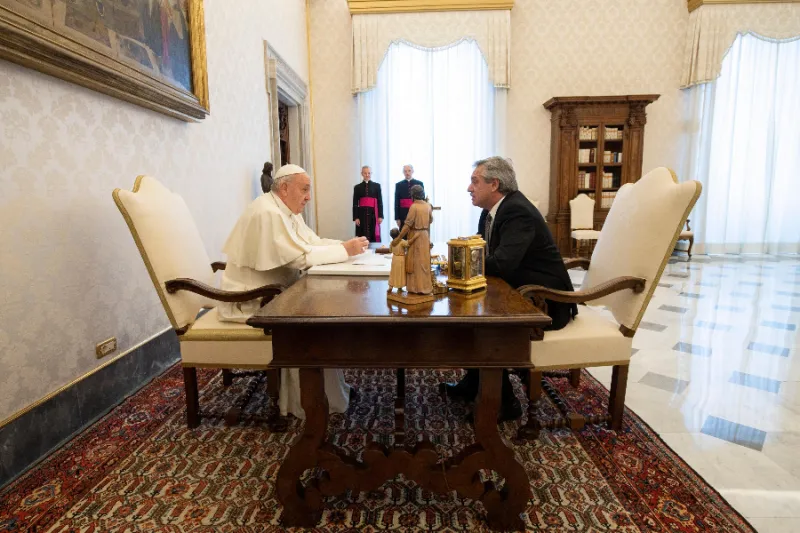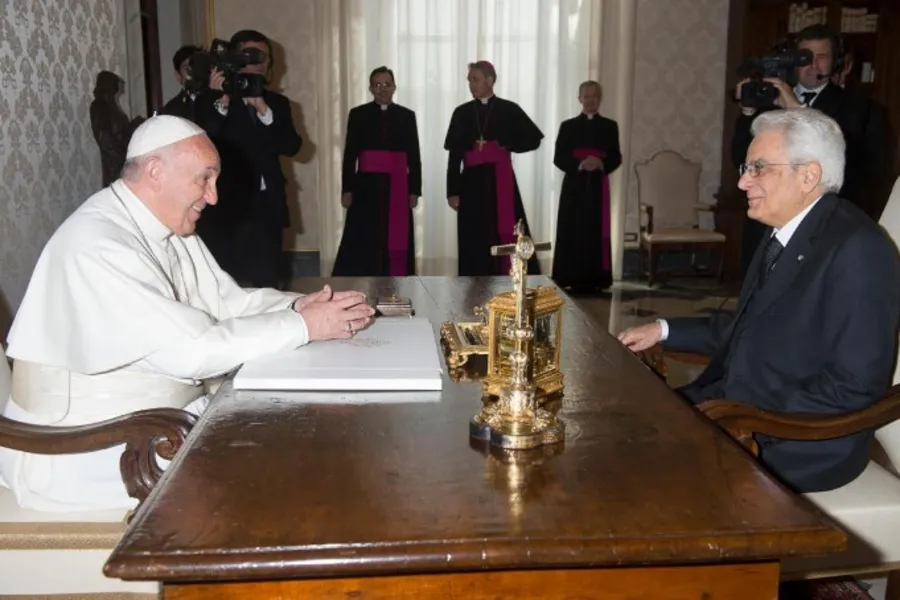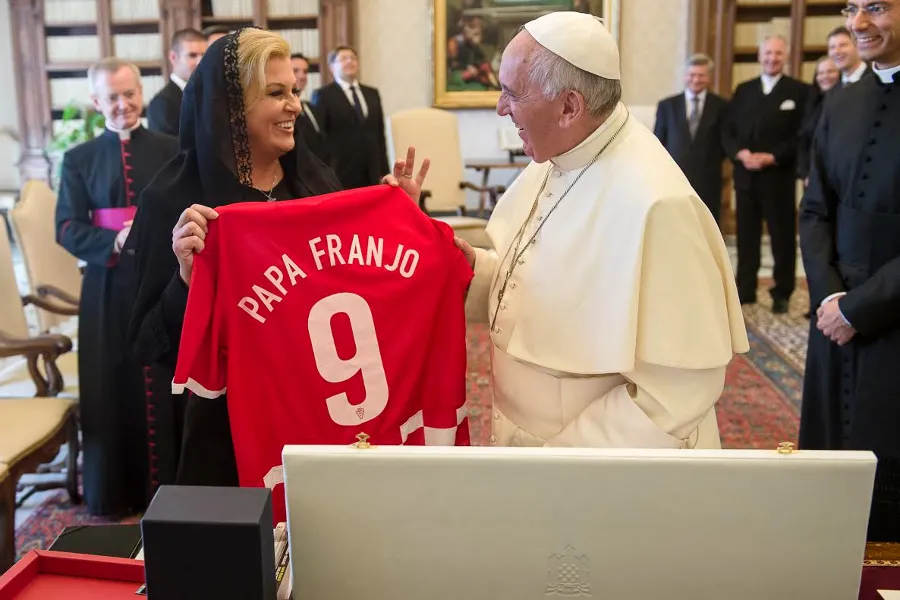
Vatican City, Aug 27, 2021 / 07:00 am (CNA).
Have you ever noticed those people who accompany visitors through the rooms of the Apostolic Palace toward the papal library, where official meetings with the pope take place? Perhaps this choreography struck you as old-fashioned and out of step with the modern world.
But these carefully choreographed scenes are full of meaning. They are part of the Vatican’s ceremonial life. This ceremonial is a language that tells us how an institution wishes to present itself to the world. Unraveling the meaning of the ceremonial helps us to grasp more of what happens inside of the Apostolic Palace.
Vatican ceremonial is made up of “apparently not very visible, but substantial things,” according to Msgr. Stefano Sanchirico, a former prelate of the Prefecture of the Papal Household.
The pope only has formal meetings with three categories of individuals: monarchs and heads of state; heads of government; and — less frequently, and exceptionally — ministers for foreign affairs.
Along with these three categories, the pope also personally meets with ambassadors accredited to the Holy See on two main occasions: when they present their credentials and when they bid farewell at the end of their missions.
There are also three categories of visit to the Vatican: a state visit, a solemn audience, and a private audience.
State visits have become very rare. The formula of the audience is now preferred, Sanchirico explains, since “it is more flexible and easy.”
The decline of state visits did not begin under Pope Francis but started a long time ago. The ceremonial, as we can see, does adapt in some ways to the times.
Considering that visits to the pope are principally diplomatic, one might think that they are regulated by the protocol of the Secretariat of State, which oversees Holy See diplomacy. But it is in fact the Prefecture of the Papal Household that manages the visits. The pope does not receive the heads of state accompanied by other senior officials but with dignitaries and family members.

The state visit is the most important of the three categories. The last such visit was made by the Italian President Sergio Mattarella on April 18, 2015. On that occasion, the protocol was adapted. Family members are not generally included in a state visit, but Mattarella was able to bring his daughter and grandchildren with him.
How does a state visit work?
“The state visit begins from St. Peter’s Square,” Sanchirico says, “where a first squad of the Swiss Guard greets the guest and then accompanies him inside the Vatican. The procession enters from the Arco delle Campane [an entrance to the Vatican on the left facing St. Peter’s Basilica], turns behind St. Peter’s Basilica, and arrives at the Courtyard of San Damaso.”
In the courtyard, the head of state finds the following people lined up: a double squad of the Swiss Guard in Grand Gala uniform, the Gentlemen of His Holiness with the Prefect of the Papal Household, and the General Councilor of the State, and the commander of the Swiss Guard. The flag of the guest’s nation is raised on a flagpole.
According to canon law, the Gentlemen of His Holiness are “lay dignitaries of the Papal Household.” Paul VI established the title of Gentlemen of His Holiness in the motu proprio Pontificalis Domus, issued on March 28, 1968. With that document, Paul VI reformed the Papal Household, streamlined the list of titles, and generally overhauled the whole structure and ethos of the papal court.
The Gentlemen of His Holiness are under the Prefecture of the Papal Household. They are summoned to receive and accompany the pope’s guests: heads of state and government, ambassadors to the Holy See, and other prominent international personalities.
The Prefect of the Papal Household introduces the guest to the dignitaries and the Gentlemen of His Holiness. After the introductions, the pontifical band plays the guest’s national anthem, and the guest is then seated in a living room next to the elevators.
“Today,” Sanchirico notes, “the delegations go up on the elevator, but previously they arrived in the Second Loggia [on the second floor] via the papal staircase.”
Each member of the guest’s delegation is assigned to a Gentleman of His Holiness.
The procession is formed in the Second Loggia, the floor where the papal library is located.
The procession is led by the commander of the squad of the Swiss Guard, who is a sergeant major. The Sediari pontifici follow. They are members of the Papal Antechamber (Anticamera Pontificia) and their role is strictly connected with the service to the pope. In the past, they carried the sedia gestatoria, or gestatorial chair, bearing the pope.
After the Sediari, other figures in the papal court join the procession, including the Decano di Sala dell’Anticamera Pontificia, who is responsible for the public part of the papal apartment and coordinates the Sediari. The Decano is followed by the Addetti di Anticamera di Sua Santità, who are also part of the Papal Family (Familia Pontificalis.)
Then there is a squad of eight Swiss Guards, in the center of which is the guest with the Prefect of the Papal Household on his right, then the spouse of the head of state, and the commander of the Swiss Guard.
Immediately behind this group are the members of the entourage of the head of state, each accompanied by a Gentleman of His Holiness.
Sanchirico says that “the procession reaches the Sala Clementina, where a section of the Swiss Guard pays the honors. During the state visit, the delegation is welcomed by the lay head of the Papal Family, the Assistant Prince to the throne. He takes the place of the dignitary who accompanies the president [head of state], who shifts his position close to the president’s wife.”
The Papal Almoner, who is part of the Papal Family, also joins the procession.
“Formally, the Almoner is a prelate of the Antechamber, a member of the participating secret chamber,” notes Sanchirico. This is because “the Almoner was a reality of charity that emanated directly from the pope; it has no universal characteristic.”
The procession leads through from the Sala dei Sediari to the Sala di Sant’Ambrogio, where there is a small passage that leads directly to the pope’s library, then to the Sala dei Papi, and the Hall of the Urban VIII Chapel.
Step by step, the procession thins out, with the guest ultimately finding themselves alone with the pope.
First, the Sediari leave the procession, then the Addetti di Anticamera, and finally the Gentlemen of His Holiness. The latter wait in the “Room of the Ambassadors,” while the spouse of the head of state stays in the “Sala Della Consorte” (Consort’s Room).
None of the guests is ever left alone. The pope welcomes only monarchs as a couple.
Arriving at the Sala del Tronetto, the pope exits the private library, greets the head of state in the center, and then leads them to the library, where the interview takes place at the papal desk, with two identical chairs.
During the private meeting, the prelates in the antechamber go to greet the other guests.
At the end of the meeting, the doors open. First, the spouse is introduced, then the guest’s entourage. Finally, each member of the staff is introduced to the pope. A state visit also includes an exchange of speeches before the group photo and farewell.
The procession resumes and the group is reconstituted step by step along the way.
First, the Papal Family greets the guest in the Clementine Hall, and then the head of state goes down to the First Loggia, where there is a meeting with the Secretary of State.
After the bilateral meeting, the procession resumes at the Sala Regia, where the guest meets with the diplomatic corps accredited to the Holy See.
Then the religious part begins. If the head of state is Catholic, they go to St. Peter’s Basilica to pay homage at the Prince of the Apostles’ tomb and perform an act of devotion in front of the image of the Madonna del Soccorso and the Blessed Sacrament.
The guest finally meets with the Chapter of St. Peter. The chapter was established in 1043 by St. Leo IX. It was intended to guarantee regular prayer in St. Peter’s and, in earlier years, to assist the pope in managing the goods of St. Peter’s patrimony.
After that, the farewell takes place, with the band performing the pontifical anthem in front of St. Peter’s Basilica.
All of this happens with the state visit. How different is this from a private audience?
“The places are the same,” says Sanchirico, “[But] the state visit involves an exchange of speeches, which does not occur during an audience.”
Of course, the ceremonial also provides for distinctions depending on the rank of the guest. If they are a monarch or head of state, the pope goes out to the Sala del Tronetto and meets them in the middle of the room. The pope does not, however, go out to welcome the head of government. The chair in which a prime minister sits is smaller and is placed differently.

Some precautions are no longer observed. For example, at the exchange of gifts, a prime minister should remain in front of the counter, thus marking a difference.
Also, the pope gives a pontifical medal to the guest and their entourage.
“This is silver if it is a prime minister, while it is always gold” if the pope is meeting with a sovereign or a head of state, Sanchirico explains.
The format of the meeting in which ambassadors present their credentials to the pope has recently been revised.
“We have returned to the previous type of ceremonial,” observes Sanchirico, “although there is no longer a distinction between ambassadors, who were received in the Throne Hall, and plenipotentiary ministers, who were received in the Tronetto Hall.”
“The ceremony is now totally public, in the presence of the delegation, and takes place in the Throne room with the subsequent private meeting in the library and has, mutatis mutandis, the same characteristics as the state visits.”
When he receives the credentials, the pope meets with the non-resident ambassadors in groups and delivers a speech. In contrast, he meets the resident ambassadors in private, with no public speech delivered.
If you value the news and views Catholic World Report provides, please consider donating to support our efforts. Your contribution will help us continue to make CWR available to all readers worldwide for free, without a subscription. Thank you for your generosity!
Click here for more information on donating to CWR. Click here to sign up for our newsletter.





Probably with equal ceremony, Charlemagne was crowned “emperor of the Romans” by Pope Leo III in A.D. 800, thus restoring the Roman Empire in the West for the first time since its dissolution in the 5th century.
How times have changed, with the rationalist Enlightenment and the rise of secular and now agnostic nation-states, and with the resurgence of 7th-century Islam. A bit of a sorting out process into distinct bailiwicks….In olden times Charlemagne gained stature because crowned by the pope, and the pope gained stature as the one who crowned emperors. Symbiosis.
Today, despite the respectful and fitting formalities, do we now detect a marginalized ghetto/dhimmi Church within a single globalized domain genuflecting before deified Technocracy and the backsliding “right side of history”?
Be mindful of who you crown. My HS history teacher Dr Hirsch would remind us with an air of finality that the Holy Roman Empire was neither holy nor Roman. Although Charlemagne’s Frankish [Frenkisk] German grandpappy Charles Martel defeated the Umayyad Arabic invasion of France and Charlemagne consolidated the empire, the Western Franks consolidated France with the indigenous Gallic Celts. The Holy Roman Empire mainly W Germany sections N France Italy in the 10th century was ruled by the East Frank Germans. Hohenzollern and Hohenstaufen dynasties ruled the empire until German unity and Kaiser Wilhelm II the last of the Hohenzollerns. The Holy Roman Empire during the 12th century was by this time headquartered in Italy at Aquila approx 50 m NE of Rome. Hohenstaufens ruled and they constantly contested territories and fought the Papal States. Heinrich Hohenstaufen married Norman Constance de Hauteville, queen of Sicily and daughter of king Roger II de Hauteville. Their son Frederick II ruled as king at Palermo and later crowned Holy Roman emperor Palermo [Constance refused his residency in Germany]. Frederick II engaged in the crusades at the pope’s behest although he continued conflict with the Pontiff over territories claimed by the Hohenstaufens. Frederick was excommunicated allegedly several times following wars, territorial settlements and repeated claims. He finally died in good grace.
“Be mindful of who you crown.” Indeed–time travel with good ol’ Frederick II…
FIRST, the pen is more powerful than the sword?
In the Sixth Crusade (1228-9) and armed with multilingual skills—including Arabic—the German emperor Frederick II secured Jerusalem through very little battle, but rather through direct negotiations with the sultan. (The sultan was also preoccupied with an internal struggle for control of Damascus.)
SECOND, so-called religious “pluralism?”
Due partly and ironically to his religious indifference, Frederick found a pragmatic way to simply declare Jerusalem a city of three religions, and then to divide the Holy Sites among the three allegiances. Frederick, in earlier years, had declared that history had produced three “imposters,” these being Moses, Christ and Mohammad. Some attribute Frederick’s success partly to the fact that the sultan in Jerusalem was same al-Malik al-Kâmil who a few years earlier in Egypt had been fascinated by St. Francis’ disarmed and disarming proselytizing.
THIRD, Church and State?
Frederick rejected the Medieval view of limited kingship with his theory of absolute state power and royal supremacy in all things both temporal (especially over control of Sicily) and spiritual. While Frederick was in Rome bartering to have himself declared heir to the papal throne, the new pope Innocent IV escaped by sea and the following year (A.D. 1245) had Frederick temporarily deposed, at the Council of Lyons.
From imperfect notes, I hope I’m accurate about all this. It is possible, too, that it was through Frederick II that Arabic numerals and Algebra first made their way into Europe.
“I’d like to place the first European, according to my taste, the Hohenstaufen Frederick II” (Nietzsche). In deference to Frederick I’m compelled to add he was called the Wonder of the World, not for attempting to crown himself pope, which I never came across [interested to know that source] rather for the royal court at Palermo where he invited Europe’s scholars as well as Arabic philosopher scholars who had recently uncovered Aristotle. Sicily was the other entry point of Aristotelian philosophy besides Spain and Ibn Rushd. Frederick established the University of Naples 1224 where Aristotle was first taught academically and where Thomas Aquinas had his initial introduction to The Philosopher. Frederick also revised and designed Sicilian as a new language, the basis for modern Italian and the Florentine adapted by Petrarch and Dante. Insofar as Frederick’s faith he didn’t oppress Catholicism and died in the faith, although he was typical in his time of the consummate modern European liberal.